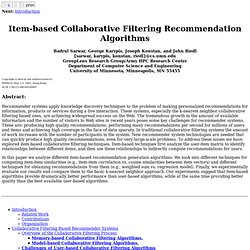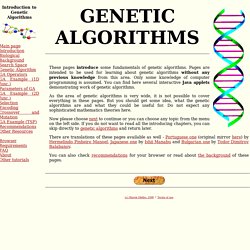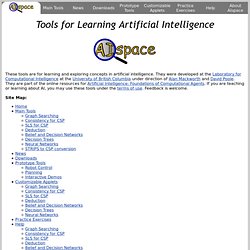

Rapid - I. Machine Learning cheat sheet Artificial Intelligence Books. Networks, Crowds, and Markets: A Book by David Easley and Jon Kleinberg. In recent years there has been a growing public fascination with the complex "connectedness" of modern society.

This connectedness is found in many incarnations: in the rapid growth of the Internet and the Web, in the ease with which global communication now takes place, and in the ability of news and information as well as epidemics and financial crises to spread around the world with surprising speed and intensity. These are phenomena that involve networks, incentives, and the aggregate behavior of groups of people; they are based on the links that connect us and the ways in which each of our decisions can have subtle consequences for the outcomes of everyone else.
Networks, Crowds, and Markets combines different scientific perspectives in its approach to understanding networks and behavior. The book is based on an inter-disciplinary course that we teach at Cornell. Topic:Artificial intelligence. Artificial Intelligence Part of the School of Computer Science Four approaches summarize past attempts to define the field: The study of systems that think like humans.The study of systems that think rationally.The study of systems that act like humans.The study of systems that act rationally.

Of these approaches, the former two are considered to be "white-box" approaches because they require our analysis of intelligence to be based on the rationale for the behaviour rather than the behaviour itself. The latter two are considered "black-box" approaches because they operationalize intelligence by measuring performance over a task domain. Although the third approach, (known as cognitive modelling), is of great importance to cognitive scientists, we concern ourselves with the fourth approach. This approach motivates us to provide a model for our intelligent systems known as the intelligent agent.
Learning projects[edit] See: Learning Projects and the Wikiversity:Learning model. Publications by Googlers in Artificial Intelligence and Data Mining. Item-based Collaborative Filtering Recommendation Algorithms. Badrul Sarwar, George Karypis, Joseph Konstan, and John Riedl {sarwar, karypis, konstan, riedl}@cs.umn.edu GroupLens Research Group/Army HPC Research Center Department of Computer Science and Engineering University of Minnesota, Minneapolis, MN 55455 Copyright is held by the author/owner(s).

WWW10, May 1-5, 2001, Hong Kong. Recommender systems apply knowledge discovery techniques to the problem of making personalized recommendations for information, products or services during a live interaction. These systems, especially the k-nearest neighbor collaborative filtering based ones, are achieving widespread success on the Web. The tremendous growth in the amount of available information and the number of visitors to Web sites in recent years poses some key challenges for recommender systems. In this paper we analyze different item-based recommendation generation algorithms. Artificial Intelligence Wikipedia-based Free Textbook. Main page - Introduction to Genetic Algorithms - Tutorial with Interactive Java Applets.
These pages introduce some fundamentals of genetic algorithms.

Pages are intended to be used for learning about genetic algorithms without any previous knowledge from this area. Only some knowledge of computer programming is assumed. You can find here several interactive Java applets demonstrating work of genetic algorithms. As the area of genetic algorithms is very wide, it is not possible to cover everything in these pages. But you should get some idea, what the genetic algorithms are and what they could be useful for. Now please choose next to continue or you can choose any topic from the menu on the left side. There are translations of these pages available as well - Portuguese one (original mirror here) by Hermelindo Pinheiro Manoel, Japanese one by Ishii Manabu and Bulgarian one by Todor Dimitrov Balabanov.
You can also check recommendations for your browser or read about the background of these pages. Machine Learning (Theory) Game AI for Developers Fast Artificial Neural Network Library. Artificial Intelligence. Artificial Intelligence Depot. AIspace. These tools are for learning and exploring concepts in artificial intelligence.

They were developed at the Laboratory for Computational Intelligence at the University of British Columbia under direction of Alan Mackworth and David Poole. They are part of the online resources for Artificial Intelligence: Foundations of Computational Agents. If you are teaching or learning about AI, you may use these tools under the terms of use. Feedback is welcome. Site Map: These tools were designed and written by Saleema Amershi, Nicole Arksey, Mike Cline, Wesley Coelho, André Gagné, Byron Knoll, Janine Li, Kevin O'Neill, Mike Pavlin, Kyle Porter, Joseph Roy Santos, Shinjiro Sueda, Leslie Tung, Audrey Yap, and Regan Yuen, under the guidance of Giuseppe Carenini, Cristina Conati, Peter Gorniak, Holger Hoos, Jacek Kisyński, Alan Mackworth, and David Poole.
Copyright © 1999 - 2010 S. For questions about the overall AIspace project please email info@aispace.org. Welcome.